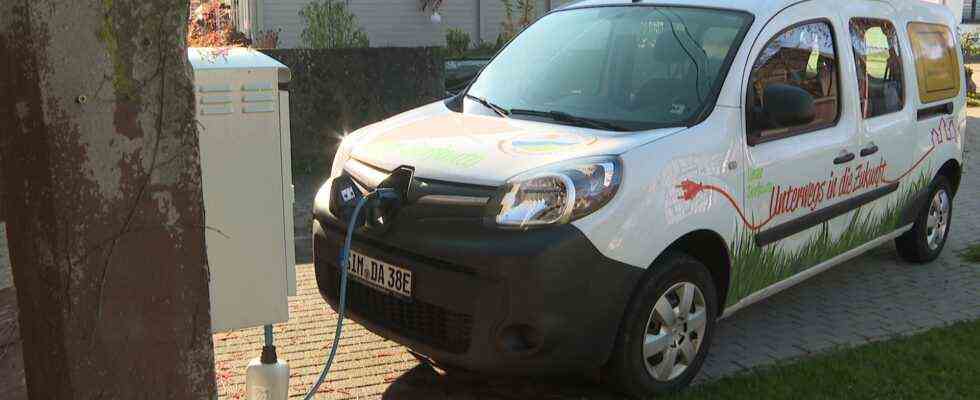ARD theme week
Status: 11/10/2021 9:30 a.m.
Car sharing is on the rise – especially in cities. A district in Rhineland-Palatinate is working to ensure that it is also popular in rural areas: with its “E-Dorfauto” project.
For two years now, the district of Rhein-Hunsrück has had electric cars switched from one district to the next – for one year at a time. Citizens then have the opportunity to try out car sharing in their town for the duration of this car guest game. Eight such “e-village cars” are in use at the same time, so eight communities or districts with between 200 and 1250 inhabitants can enjoy free e-mobility in one year.
Relief for villagers
One of them is Barbara Trost: “That is a great relief for everyone here in the village. We recently used it to transport a washing machine or drinks for the clubhouse,” says the resident. “And you don’t have to worry about TÜV or inspection. Nevertheless, you always have a car that you can use.” In addition to car sharing, the project also aims to bring electric mobility closer. This idea caught on at Trost: “The car makes you want to use e-mobility. It is fun to drive the car and you have a clear conscience. It is now also a dream of ours that we will one day get an electric car gain. “
Rent-a-car owners like Trost are collecting a lot of kilometers: more than 330,000 of them have now been driven by e-village cars with zero emissions. That is far more than double what car sharing operators usually expect, says Bernd Kunz from the Energy Agency Rhineland-Palatinate, which is accompanying the project. “Here in the district, with around 104,000 inhabitants, we have more than 70,000 registered cars. And that is simply a very, very large number.” The village car is supposed to help reduce this number.
E-car rental is unbureaucratic
It seems to be working: more than 750 people from Rhein-Hunsrück are registered users and have booked a car more than 3300 times. Statistically speaking, every car is used more than once a day. Registration and a user contract are a prerequisite, then a small chip is stuck to the driver’s license, with which the car can be opened. It must be booked beforehand – using your own software on the Internet.
Leasing and booking software cost up to 8,000 euros a year for an e-vehicle. “Compared to the high usage, that’s a manageable amount,” says Kunz. In addition, there are installation costs for charging points in the local communities. “One condition of the project was that the community get the electricity for the cars from renewable energies.” There are no costs for instructing customers or keeping vehicles clean and inspecting them: so-called carers, at least one in each village, take on the tasks on a voluntary basis.
Minimum number of users is required
Stefan Bratzel, Director of the Center of Automotive Management (CAM) in Bergisch Gladbach, explains why car sharing has become established on its own in cities and why the municipality has to help out in rural areas: “Private car sharing needs a minimum number of users. This is more likely to be the case in large cities . ” The fixed costs for organization or logistics are particularly worthwhile for larger car sharing fleets. “However, if a volunteer caretaker takes over part of the organization, even small fleets or individual vehicles can pay off.” Car sharing in rural areas is underestimated, according to Bratzel. “Even though the density of cars per household is high there, well-organized car sharing can make a contribution to more sustainable mobility.”
What is exciting about the project in the Rhein-Hunsrück district is that the residents of the villages can also be enthusiastic about sharing cars and new technologies. “And in addition, such village cars also promote social coexistence. Since anonymity is low in villages, the law of reunion also ensures that the vehicles are treated with care.”
Barely one and a half people per car
Transport scientist Heiner Monheim also relies on the principle of “reunion is fun”: “I believe that digital hitchhiking – that is, taking along – has a very relevant future for rural areas.” This includes the village or citizen car. “But also an app on which registered drivers as providers and registered non-car owners or non-car users can be taken along.” For this purpose, an internet-based app can be established in which police clearance certificates, insurance regulations or security issues are stored.
“And then there is simply the quick possibility of registering a trip request on the Internet, and shortly afterwards a car will stop and pick you up,” says Monheim. In the past, driving instructors would have warned not to lend cars. “In my lectures I like to remind you that up until the late 1950s the average occupancy rate for cars in rural areas was 3.6.” Today there are only 1.4 people in a car. “Back then, almost everyone who drove a car took other people with them.” Because the car was a rare commodity. “We now have an extremely high level of motorization and therefore the typical climate problems with far too much car traffic, even in rural areas.” In this way, the village car could in a sense become a sensible alternative to more bypass roads.
The project will run for another year
The eight village cars are supposed to be passed from village to village for a year, after which the project period will expire after three years. But there is already a follow-up project. “Here the use will no longer be free for the citizen. Nevertheless, the costs will not be covered, which is why the district will continue to pay subsidies,” explains Bernd Kunz from the Energy Agency Rhineland-Palatinate. So soon 20 village cars are to be lent – subsidized by public money, but cheaper than some bus routes.

